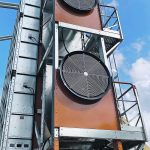GSI announced in mid-September that it was introducing a new line of mixed flow grain dryers, which will be available for the 2025 growing season. That, according to the company, now gives it one of the broadest ranges of dryer types on the market from any one brand. According to Alan Lockwood, GSI’s product manager […] Read more
Tag Archives grain drying

Biomass takes the heat out of the carbon tax
Manitoba company turns major farm expense into an asset by using alternative fuel sources for grain drying
With all the grumblings about the federal carbon levy’s effect on grain drying costs, a company that promises its technology can use a fuel source exempt from the tax should have customers lining up. “There are two sides to that,” said Triple Green chief executive officer Lyall Wiebe. “Obviously, there’s lots of interest, but there […] Read more
Producers oppose carbon tax bill amendment
A Senate amendment to a private member’s bill would exempt grain drying but not barn heating and greenhouses
Farm organizations and farmers across the country urge senators to defeat an amendment to Bill C-234 that removed barns and greenhouses from a potential carbon pricing exemption. The proposed changes mean the bill, which would amend the Greenhouse Gas Pollution Pricing Act, would exempt natural gas and propane used for grain drying but not barn […] Read more
Grain drying alternatives called few
Engineers working on grain drying technology said alternatives to fossil fuels are years away. William David Lubitz, associate professor at the University of Guelph’s school of engineering, and Chandra Singh, senior research chair in agricultural engineering and technology at Lethbridge College, told the Senate agriculture committee that farmers have no viable replacements for propane and […] Read more

Grain drying cost drops drastically
The cost to dry corn today is about 2.4 percent of corn’s value. That’s a significant drop from 1980 when the cost was about 18 percent of the corn’s value. On the Prairies, this change results from more efficient dryers and better access to natural gas and liquified propane, says GSI specialist Lee Bonn. “In […] Read more

What’s better, mixed flow or conventional dryer?
Cross flow
Mixed flow dryers are up to 30 percent more fuel efficient than conventional screen dryers. That efficiency relates to how air flows through the dryer, and that depends on dryer design. “In a conventional cross-flow, the air flows perpendicular to the grain. The grain column is vertical and the air flow is horizontal,” said Lee […] Read more
Carbon pricing exemption bill not likely to pass until fall
The chances of Bill C-234 making it through the Senate before the summer recess are slim. The bill to exempt propane and natural gas used to dry grain or heat farm buildings from carbon pricing passed second reading June 13, but two committees would have to fast track to pass it before June 23. The […] Read more

Dryer efficiency tough to pin down
Farmers pour a lot of crop and energy through grain dryers, but it’s hard to tell how well or poorly those dryers are doing. “There’s not a lot of good, reliable data for what is the baseline,” said Charley Sprenger, an engineering researcher with the Prairie Agricultural Machinery Institute. “What are we trying to improve […] Read more

TopDry makes double use of heat
The GSI TopDry is simply a dryer located just inside the roof of a grain bin. This layer of grain in the overhead drying chamber is dried by a heater and fan. Hot dry air is channelled up to the roof through a ductwork on the side of the bin. The layer of grain at […] Read more

New grain dryer tool runs on biomass
REGINA — A biomass-fueled grain drying system on display at Canada’s Farm Show in Regina offers a path for farmers and elevators to avoid paying the carbon tax when drying grain. “So essentially, what we’re trying to do here is take producers off of fossil fuels and to burn biomass, and we’re able to help […] Read more




